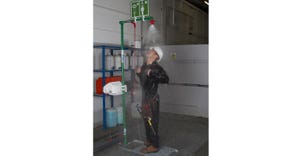Sampling: A Vital Process in Evaluating Blending and Segregation Problems
March 15, 2011
Eric P. Maynard
[email protected]
|
Eric P. Maynard |
Effective sampling is essential in determining the state of the blend in a mixer and in downstream equipment such as a bin, hopper, or packaging system. Though information on mechanisms of particle segregation and blending technology is available, general practices for sampling of powders is not as easily located. To achieve a high level of confidence in the quality of the samples extracted from a process, ponder the following five points regarding sampling.
First, know that a perfect blend does not guarantee a perfect product. Consider that every time a transfer step occurs in a powder handling process, the mix or blend has the potential to segregate. Common segregation mechanisms occurring during industrial powder handling applications include sifting, fluidization, and dusting. Depending upon which mechanism of segregation occurs, the fine and coarse particles will concentrate in different locations in the bin or hopper, thus rendering location-specific sampling results. Sample also at each piece of equipment the powder has transferred into to evaluate if segregation has resulted due to powder transfer.
Second, analyze the entire sample collected or carefully split down the sample size to a smaller representative size used in the analysis (e.g., chemical assay, pH, particle size). For example, let’s say a 500-gram sample is collected from a hopper, then segregates in the sample container. If the laboratory technician then collects a small 5-gram grab sample for analysis, this smaller sample may not represent the true particle size distribution of the entire sample and error results. In this case, a sample splitter, such as a rotary riffler, can be used to accurately reduce the sub-sample size. Avoid using old-school sample splitting methods like cone and quarter or chute riffling, which are more prone to error. Additionally, samples collected over time and combined into a composite sample can only tell you at-best what is the quality of material over that period. Furthermore, if the composite sample is not well-mixed, sampling bias can result.
Third, beware of the thief! A sample thief is commonly used to collect powder samples from a stationary bed of material in a blender, drum, or bin. A thief is a metal rod with recessed cavities capable of receiving powder after being inserted into a powder bed. Care must be made with thief-collected samples because this method will disturb the powder sample in-situ and some components may or may not flow into or stick to the thief cavity. Numerous studies have shown that thief sampling results can be dependent on operator technique (e.g., thief insertion angle, penetration rate, angle, twisting). I am not proposing that thief samplers be abandoned; rather, I suggest that the resulting data be carefully scrutinized and observations (e.g., static cling, agglomeration, smearing) of the thief cavity and extracted powder sample be recorded.
Fourth, improve the quality of thief sampling with a stratified (nested) approach and statistical analysis to differentiate blend variability from sampling error (from the thief, laboratory analysis, or collection method). Instead of sampling only once from a given location in a blender, multiple (minimum of three) thief samples should be extracted from the same location. This should then be repeated throughout several distinct locations, especially in known “dead-zones” like at the blender walls. After analysis of these samples, assessments can be made to within-location versus between-location variability. If the three samples collected at the same point have large variability, then questions should be raised regarding the thief or analytical testing method. If large variability exists between the samples collected around the blender, then it is likely that the blend is not yet complete and additional time or agitation will be required; it is also possible that segregation may have occurred within the blender due to over-blending.
Fifth, consider an alternative sampling approach, such as full-stream sampling during blender discharge. This technique provides a true “snap-shot” of blend uniformity exiting the blender and overcomes many of the pitfalls common to the sample thief.
Do you know if your sampling data are accurate or could the data be showing something that is not really there?
Eric Maynard is a senior consultant and director of education at Jenike & Johanson (Tyngsboro, MA) and a member of Powder/Bulk Solids’ editorial advisory board.
You May Also Like



